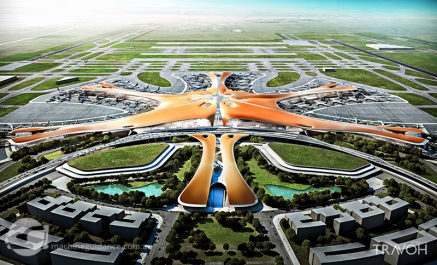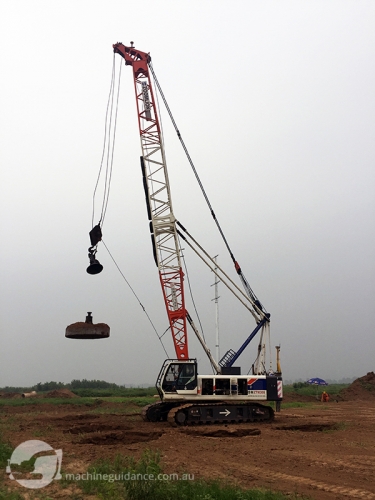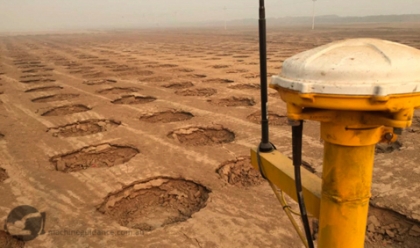Compaction Technology For New Beijing Airport
When Beijing’s Daxing Airport opens in 2019 it will reside on solid ground--its flat, compact and reliable base prepared with the help of machine-guided dynamic compaction technology.
Published: April 2018
Author: Trimble Civil Engineering & Construction Division

Highlights
• Optimal construction efficiency
• Accurate measurement of weight drop displacement
• Minimal personnel required onsite for a safer workflow
• Accurate recording of machine coverage, speed, and compaction quality
Overview
Beijing Daxing Airport was designed by airport specialists ADPI in collaboration with renowned architect Dame Zaha Hadid. When completed, the new airport will comprise a striking organic-looking central hub with six sweeping curved spokes. Its total floor area will reach 700,000 m2 (2,300,000 sq ft); an 80,000 m2 (262,470 sq ft) ground transportation center will link to high-speed rail, metro, expressways, buses and an inter-airport transportation system.
By 2025 Daxing Airport is projected to handle approximately 72 million travellers, 2 million tons of shipping and 620,000 flights per year. The Daxing Airport site is located 67 km (220 mi) from BCI and 46 km (151 mi) north of Tian-an-men Square.
The Challenge
Daxing Airport is owned by Beijing New Airport Headquarters (BNAH); three supervisory companies under BNAH oversee 14 airport construction contractors for flight zone construction. “It’s a massive project,” says Michael Lv, a Trimble project manager on the new airport. “The airport, which will feature the world’s largest single terminal, will comprise four runways and eight taxiways built on 2,400 ha (5930 ac). It has an unprecedented amount of civil aviation investment by the Chinese government.”
Before construction of an airport of these dimensions could commence, an enormous amount of land preparation work had to be carried out, including a long process of engineered soil compression to form a solid base. This process would involve adding new soil material to the site then compacting the area to the desired firmness.
“To ensure accuracy and the best efficiency on the airport project, BNAH required all companies and contractors to digitally control construction methods to record and track quality, progress, and efficiency,” said Lv. So when BNAH’s technology solution tender was created it included tightly defined requirements for dynamic, impact and vibration compaction; field supervision survey tools; concrete vehicle tracking; and all relevant software.
BNAH chose to partner with Trimble, because it was able to meet every requirement of the tender.
The Solution
At the Daxing site, excavators and dozers performed cut/fill work first. Then soil compaction commenced using a mix of dynamic and roller compaction methods. For the dynamic method, a crane was equipped with a GNSS-guided Trimble DPS900 Machine Control System to ensure maximum efficiency. The crane would drop a heavy weight (hammer) on the ground at regularly spaced intervals--the impact of each drop would create stress waves that penetrated the soil up to 10 m (33 ft), causing it to densify.

The Solution 2
The Trimble DPS900 system included two Trimble Zephyr 2 Rugged Antennas and two receivers: the Trimble SPS855 GNSS Modular Receiver and the Trimble SPS555H GNSS Heading Add-on Modular Receiver for heading. GNSS corrections were received from an SPS855 base that installed in the site.
Construction plans designed in AutoCAD software were imported into Business Center - HCE software, edited and processed into the Trimble design format, then wirelessly sent to the crane via China Unicom cellular channels. The DPS900 system then guided the rig operator to each drop location--navigation was as simple as the operator following a crosshair on the Site Tablet’s screen. No stakes were ever needed; each hammer drop was automatically recorded.
In dynamic compaction, the first drop penetrates to the greatest depth; the following drops compact the shallower layers. The weight used and the height from which it is dropped determine the degree of compaction, along with the spacing of the drops. For Daxing Airport, there are two kinds of dynamic construction levels: 1000 kN and 2000 kN for different flight zone regions.
The dynamic process was followed by impact compaction using tractors, then soil compaction with rollers. These machines were installed with the Trimble CCS900 Compaction Control System. This solution enables compaction teams to compact surface material to a target density and check finished grade accuracy in the same process. “The CCS900 technology really helps impact and roller compaction by accurately recording machine coverage, speed, and compaction quality,” says Lv.
At the Daxing site the first compaction pass lowered the original ground surface by 3 m (10 ft), at which time new material (soil and crushed stones) was added and the compaction process was repeated. Ultimately, the compaction team added 8-25 layers (soil lifts) of new material all over the airport site in order to achieve the density defined by its geotechnical engineers.

The Solution 3
Accurate spacing between hammer drops was critical, but with a GNSS on-machine guidance system the compaction team easily achieved the accuracy they needed without stakes.
Another critical component of the technology solution at the Daxing site was the Trimble Construction Information System (CIS), a web-based, real-time information exchange platform that was created for BNAH. Using the CIS, various airport stakeholders could share information at every stage of the compaction process.
“When one of the machines was finished working, all its recorded data would be synced to the CIS immediately,” says Lv. “The site supervisor could check and report on the work.” Business Center - HCE was sometimes used to review and evaluate the final construction results.
The Results
By using the most advanced construction technology to integrate construction and operations, BNAH is constructing the airport more safely and efficiently, managing transparently, and maximizing construction quality.
Chief Engineer of BNA, Li Qiang, said "Trimble digital construction solution has helped the project owner clearly and immediately know on site construction status, which is a first in Chinese airport construction projects."
The accurate, stakeless navigation of the dynamic compaction process ensured maximum efficiency and productivity, and consistent compaction throughout the job site. Navigation to each drop location was faster, so more drops could be performed in a day. The system also prevented errors and avoided rework, creating yet another avenue for saving valuable construction time and reducing costs.
Safety was improved on the site through not needing personnel to stand near the machine installing stakes. The system even eliminated blind spots by notifying operators of areas to avoid.
The automatic as-built recording that took place with every action of the machines generated accurate reports to track drop counts, displacement, and energy for each drop location. BNAH contractors must provide detailed documentation to prove that target compaction levels have been met. So the capability of Trimble-equipped machines to collect and document comprehensive, real-time compaction data is invaluable. The information can be analysed and used to generate detailed reports and documentation.
Next Steps
BNAH is now in the material and pipeline phase of construction, and it is looking to deploy machine guidance technology more widely throughout the new airport project. Approximately 15 more on-machine guidance systems have been ordered. “For example, the Trimble CCS900 will be widely used for cement-stabilised layer compaction,” says Lv.
When Beijing Daxing Airport opens in late 2019, BNAH--and the millions of travellers arriving and departing--will have peace of mind that not only is the airport’s foundation solid; the processes used to construct the airport were solid too.
Credit Source
Article courtesy of Trimble Civil Engineering and Construction.
Return to Articles

